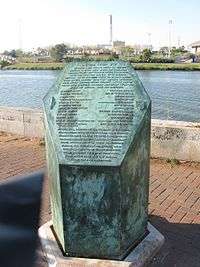Operation Boatswain
Operation Boatswain (known in Hebrew as כ׳׳ג יורדי הסירה, kaf-gimel yordei ha-sira, "the twenty-three who went down with the ship") was the first of the operational missions carried out by the Palmach as part of the cooperation between the Jewish Yishuv in Mandatory Palestine and the British during World War II. The mission to sabotage oil refineries in Tripoli was unsuccessful, ending with the disappearance of 23 Palmach commandos and British SOE Officer Major Sir Anthony Palmer after their boat was lost at sea on May 18, 1941.
Palmach
The Palmach was established by the Haganah High Command on 14 May 1941. Its two primary aims were to protect the Yishuv against attacks by Arabs in the event of a British retreat from Palestine and defence of Palestine against an Axis Powers invasion. Yitzhak Sadeh was named as Palmach commander. Initially the group consisted of around one hundred men.
Operation
In the early summer of 1941 the British military authorities agreed to joint operations against Vichy France forces in Lebanon and Syria. The first planned action was a sabotage mission against oil installations at Tripoli, Lebanon. It was feared that the refinery would provide the Wehrmacht aircraft fuel, and help thwart the planned invasion of Lebanon and Syria. The refinery was in an area well fortified by a unit of Senegalese troops from hostile French army.
A plan emerged for a motor launch, carrying 23 Palmach commandos and a Major Palmer acting as an observer, to embark from Haifa. Upon arrival, three of the Palmach would remain aboard while the rest sabotaged the Tripoli refineries. Practice runs in Caesarea had achieved excellent results.
On the night of May 18, 1941, the police were ordered to give up one of their best launches.[1] Palmer and the 23 then took over the Sea Lion (Ari Hayam in Hebrew), cast off and were never seen again. It has never been determined exactly what happened to them.[2]
Recently, it has been suggested that the 24 were killed by an explosion, possibly the result of a submarine attack, or possibly due to accidental detonation of the explosives they carried, and the boat was sunk at sea. According to an Israeli historian Aryeh Yitzhaki, the boat was destroyed by explosives that went off while at sea, killing all aboard, and some of the bodies were found by Yosef Kostika, a Haganah agent then stationed in Tripoli, after they washed up on Tripoli's shore. Kostika allegedly sent a detailed report back to Palestine, but Palmach commanders decided to cover it up so as not to lower morale and motivation to enlist in the Palmach.[3] Other research suggests that the Sea Lion did reach Tripoli, but was intercepted by the local coast guard.[4]
Victims
The 24 victims of the operation were as follows:[5]
- Major Sir Anthony Palmer
- Zvi Spector
- Katriel Yaffe
- Yitzhak Hecker
- Shimon Utchitel
- Aryeh Barzilai-Eizen
- Yaakov Gordon
- Aryeh Gelbert
- Efraim Veiman
- Chaim Weisman
- Shmuel Hanovitz
- Ariel Temes
- Baruch Yaakovson
- Mordechai Cohen
- Israel Norden-Nord
- Avraham Nuriel
- David Nafcha
- Neriel Paglin
- Mordechai Plonchik
- Yehuda Zerner
- Gershon Kopler
- Menachem Korakin
- Ze'ev Rotman
- Amiram Shochat
Legacy
This was the first act of the Palmach. The failure of the mission and loss of the 23 were blows to morale and delayed the building of Jewish naval power. The legacy of the "23 Who Went Down at Sea" was a source of inspiration to both the Palmach and Palyam, and their memory remains a source of inspiration to IDF soldiers and sailors.
The memory of the 23 has been immortalized in various ways. The immigrant ship Kaf Gimel Yordei Ha’Sira (23 Seamen, כ"ג יורדי הסירה), which arrived in Haifa carrying 790 illegal immigrants in 1946 was named after them. The Israeli Nautical College in Acre and many streets in Israel have also been named after the 23, particularly "Rechov 23 Yordei HaSira" in the trendy Tel-Aviv Port area. They are also honoured by a memorial in Mount Herzl in Jerusalem. and a memorial where they were last seen, by the Yarkon River in Tel Aviv.However, not until January 2015 did Archivist of AJEX and historian, Martin Sugarman, succeed after a long campaign, in persuading the Commonwealth War Graves Commission in formally commemorating the 23 Palmach men on their web site and also the inscribing of all their names on the Memorial to the Missing at Brookwood, Surrey. In this he was assisted by Col Neri Areli of the IDF Missing in Action Commission.

References
| Wikimedia Commons has media related to 23 Who Went Down at Sea. |
- ↑ "Mystery off the coast of Lebanon". The Independent. London. 16 September 2010.
- ↑ HaCohen, David. Time to Tell: An Israeli Life, 1898-1984. Rosemont Publishing and Printing Corp. Retrieved 19 August 2012.
- ↑ Miskin, Maayana. "Govt. Cover-Up over Fate of Secret Libya Mission, Historian Says". Arutz Sheva. Retrieved 19 August 2012.
- ↑ Fisk, Robert (4 September 2010). "On the trail of a dead British major in Vichy Lebanon". The Independent. London. Retrieved 19 August 2012.
- ↑ The 23 Who Went Down at Sea ("Kaf Gimel Yordei Ha’Sira - כ"ג יורדי הסירה")